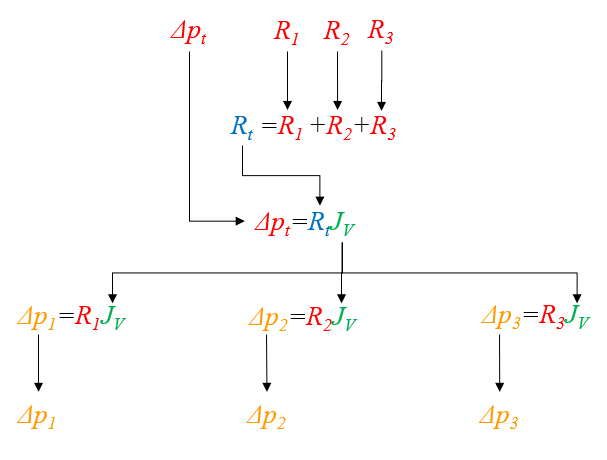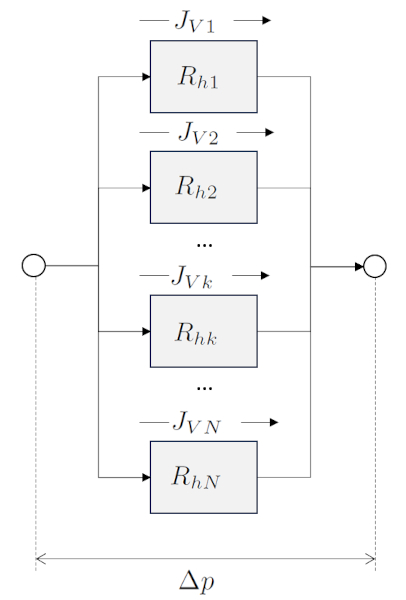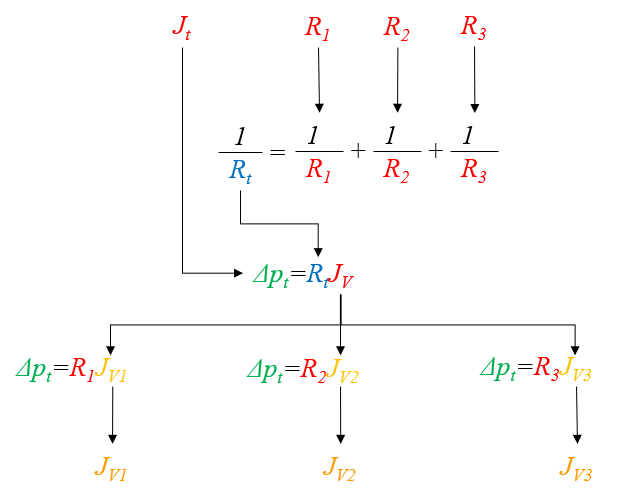Hydraulic element networks
Storyboard 
When comparing Darcy's law to Ohm's law in electricity, we notice an analogy where the flow of liquid resembles electric current, the pressure difference relates to the voltage difference, and hydraulic elements are compared to their hydraulic resistances, similar to electric resistors.
This analogy implies that, just as there are electrical networks, hydraulic networks can also be defined in which total hydraulic resistances are calculated based on partial hydraulic resistances.
ID:(1388, 0)
Hydraulic element networks
Storyboard 
When comparing Darcy's law to Ohm's law in electricity, we notice an analogy where the flow of liquid resembles electric current, the pressure difference relates to the voltage difference, and hydraulic elements are compared to their hydraulic resistances, similar to electric resistors. This analogy implies that, just as there are electrical networks, hydraulic networks can also be defined in which total hydraulic resistances are calculated based on partial hydraulic resistances.
Variables
Calculations
Calculations
Equations
The volume flow ($J_V$) can be calculated from the hydraulic conductance ($G_h$) and the pressure difference ($\Delta p$) using the following equation:
Furthermore, using the relationship for the hydraulic resistance ($R_h$):
results in:
The volume flow ($J_V$) can be calculated from the hydraulic conductance ($G_h$) and the pressure difference ($\Delta p$) using the following equation:
Furthermore, using the relationship for the hydraulic resistance ($R_h$):
results in:
The volume flow ($J_V$) can be calculated from the hydraulic conductance ($G_h$) and the pressure difference ($\Delta p$) using the following equation:
Furthermore, using the relationship for the hydraulic resistance ($R_h$):
results in:
The volume flow ($J_V$) can be calculated from the hydraulic conductance ($G_h$) and the pressure difference ($\Delta p$) using the following equation:
Furthermore, using the relationship for the hydraulic resistance ($R_h$):
results in:
The volume flow ($J_V$) can be calculated from the hydraulic conductance ($G_h$) and the pressure difference ($\Delta p$) using the following equation:
Furthermore, using the relationship for the hydraulic resistance ($R_h$):
results in:
One way to model a tube with varying cross-section is to divide it into sections with constant radius and then sum the hydraulic resistances in series. Suppose we have a series of the hydraulic resistance in a network ($R_{hk}$), which depends on the viscosity ($\eta$), the cylinder k radio ($R_k$), and the tube k length ($\Delta L_k$) via the following equation:
In each segment, there will be a pressure difference in a network ($\Delta p_k$) with the hydraulic resistance in a network ($R_{hk}$) and the volume flow ($J_V$) to which Darcy's Law is applied:
the total pressure difference ($\Delta p_t$) will be equal to the sum of the individual ERROR:10132,0:
therefore,
$\Delta p_t=\displaystyle\sum_k \Delta p_k=\displaystyle\sum_k (R_{hk}J_V)=\left(\displaystyle\sum_k R_{hk}\right)J_V\equiv R_{st}J_V$
Thus, the system can be modeled as a single conduit with the hydraulic resistance calculated as the sum of the individual components:
The parallel total hydraulic conductance ($G_{pt}$) combined with the hydraulic conductance in a network ($G_{hk}$) in
and along with the hydraulic resistance in a network ($R_{hk}$) and the equation
leads to the total hydraulic resistance in parallel ($R_{pt}$) via
Since the hydraulic resistance ($R_h$) is equal to the hydraulic conductance ($G_h$) as per the following equation:
and since the hydraulic conductance ($G_h$) is expressed in terms of the viscosity ($\eta$), the tube radius ($R$), and the tube length ($\Delta L$) as follows:
we can conclude that:
The total hydraulic resistance in series ($R_{st}$), along with the hydraulic resistance in a network ($R_{hk}$), in
and along with the hydraulic conductance in a network ($G_{hk}$) and the equation
leads to the total Series Hydraulic Conductance ($G_{st}$) can be calculated with:
With the total flow ($J_{Vt}$) being equal to the volume flow in a network ($J_{Vk}$):
and with the pressure difference ($\Delta p$) and the hydraulic conductance in a network ($G_{hk}$), along with the equation
for each element, it leads us to the conclusion that with the parallel total hydraulic conductance ($G_{pt}$),
$J_{Vt}=\displaystyle\sum_k J_{Vk} = \displaystyle\sum_k G_{hk}\Delta p = G_{pt}\Delta p$
we have
If we examine the Hagen-Poiseuille law, which allows us to calculate the volume flow ($J_V$) from the tube radius ($R$), the viscosity ($\eta$), the tube length ($\Delta L$), and the pressure difference ($\Delta p$):
we can introduce the hydraulic conductance ($G_h$), defined in terms of the tube length ($\Delta L$), the tube radius ($R$), and the viscosity ($\eta$), as follows:
to arrive at:
Examples
In the context of electrical resistance, there exists its inverse, known as electrical conductance. Similarly, what would be the hydraulic conductance ($G_h$) can be defined in terms of the hydraulic resistance ($R_h$) through the expression:
In the context of electrical resistance, there exists its inverse, known as electrical conductance. Similarly, what would be the hydraulic conductance ($G_h$) can be defined in terms of the hydraulic resistance ($R_h$) through the expression:
In the context of electrical resistance, there exists its inverse, known as electrical conductance. Similarly, what would be the hydraulic conductance ($G_h$) can be defined in terms of the hydraulic resistance ($R_h$) through the expression:
The hydraulic resistance ($R_h$) for an element modeled as a cylindrical tube can be calculated using the tube length ($\Delta L$), the tube radius ($R$), and the viscosity ($\eta$) through the following equation:
and the hydraulic conductance ($G_h$) can be calculated using:
which are related by:
Both the hydraulic resistance ($R_h$) and the hydraulic conductance ($G_h$) allow for a relationship between the variación de la Presión ($\Delta p$) and the volume flow ($J_V$) using:
or
In the case of hydraulic resistances connected in series:
the sum of the pressure drop ERROR:10132,0 across each ERROR:9887,0 corresponds to the total pressure difference ($\Delta p_t$):
while the total hydraulic resistance in series ($R_{st}$) is described by:
and the total Series Hydraulic Conductance ($G_{st}$) is defined by:
First, values for the hydraulic resistance in a network ($R_{hk}$) are calculated using the variables the viscosity ($\eta$), the cylinder k radio ($R_k$), and the tube k length ($\Delta L_k$) through the following equation:
These values are then summed to obtain the total hydraulic resistance in series ($R_{st}$):
With this result, it is possible to calculate the volume flow ($J_V$) for the total pressure difference ($\Delta p_t$) using:
Once the volume flow ($J_V$) is determined, the pressure difference in a network ($\Delta p_k$) is calculated via:
For the case of three resistances, the calculations can be visualized in the following chart:
In the case of hydraulic resistances connected in series:
the sum of the pressure drop ERROR:10132,0 across each ERROR:9887,0 corresponds to the total pressure difference ($\Delta p_t$):
while the total hydraulic resistance in series ($R_{st}$) is described by:
and the total Series Hydraulic Conductance ($G_{st}$) is defined by:
First, values for the hydraulic resistance in a network ($R_{hk}$) are calculated using the variables the viscosity ($\eta$), the cylinder k radio ($R_k$), and the tube k length ($\Delta L_k$) through the following equation:
These values are then summed to obtain the total hydraulic resistance in series ($R_{st}$):
With this result, it is possible to calculate the variación de la Presión ($\Delta p$) for the total hydraulic resistance in parallel ($R_{pt}$) using:
Once the variación de la Presión ($\Delta p$) is determined, the volume flow in a network ($J_{Vk}$) is calculated via:
For the case of three resistances, the calculations can be visualized in the following chart:
Since the hydraulic resistance ($R_h$) is equal to the inverse of the hydraulic conductance ($G_h$), it can be calculated from the expression of the latter. In this way, we can identify parameters related to geometry (the tube length ($\Delta L$) and the tube radius ($R$)) and the type of liquid (the viscosity ($\eta$)), which can be collectively referred to as a hydraulic resistance ($R_h$):
With the tube radius ($R$), the viscosity ($\eta$) and the tube length ($\Delta L$) we have that a hydraulic conductance ($G_h$) is:
In the context of electrical resistance, there exists its inverse, known as electrical conductance. Similarly, what would be the hydraulic conductance ($G_h$) can be defined in terms of the hydraulic resistance ($R_h$) through the expression:
Darcy rewrites the Hagen Poiseuille equation so that the pressure difference ($\Delta p$) is equal to the hydraulic resistance ($R_h$) times the volume flow ($J_V$):
With the introduction of the hydraulic conductance ($G_h$), we can rewrite the Hagen-Poiseuille equation with the pressure difference ($\Delta p$) and the volume flow ($J_V$) using the following equation:
The total pressure difference ($\Delta p_t$) in relation to the various ERROR:10132,0, leading us to the following conclusion:
When there are multiple hydraulic resistances connected in series, we can calculate the total hydraulic resistance in series ($R_{st}$) by summing the hydraulic resistance in a network ($R_{hk}$), as expressed in the following formula:
In the case of hydraulic resistances in series, the inverse of the total Series Hydraulic Conductance ($G_{st}$) is calculated by summing the inverses of each the hydraulic conductance in a network ($G_{hk}$):
The sum of soil layers in parallel, denoted as the total flow ($J_{Vt}$), is equal to the sum of the volume flow in a network ($J_{Vk}$):
The total hydraulic resistance in parallel ($R_{pt}$) can be calculated as the inverse of the sum of the hydraulic resistance in a network ($R_{hk}$):
The parallel total hydraulic conductance ($G_{pt}$) is calculated with the sum of the hydraulic conductance in a network ($G_{hk}$):
Darcy rewrites the Hagen Poiseuille equation so that the pressure difference ($\Delta p$) is equal to the hydraulic resistance ($R_h$) times the volume flow ($J_V$):
Darcy rewrites the Hagen Poiseuille equation so that the pressure difference ($\Delta p$) is equal to the hydraulic resistance ($R_h$) times the volume flow ($J_V$):
Darcy rewrites the Hagen Poiseuille equation so that the pressure difference ($\Delta p$) is equal to the hydraulic resistance ($R_h$) times the volume flow ($J_V$):
Darcy rewrites the Hagen Poiseuille equation so that the pressure difference ($\Delta p$) is equal to the hydraulic resistance ($R_h$) times the volume flow ($J_V$):
ID:(1388, 0)




